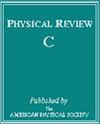Effect of lattice compression on the Li7 recoil energy spectrum following electron capture decay of Be7
IF 3.4
2区 物理与天体物理
Q1 Physics and Astronomy
引用次数: 0
Abstract
The significant increase in the () ratio of implanted in tantalum, compared to that in mercury telluride, has been quantitatively explained by using ab initio density functional calculations. The result highlights the effect of lattice compression on the () ratio of . Predictions for the () ratio in several untested cases have also been provided. Density functional calculations were employed to understand the notable downward shift observed in the capture to the nuclear ground state (-GS) peak in the recoil energy spectrum of following the electron capture decay of implanted in a small tantalum lattice and the resulting reduced energy difference between the -GS and -GS peaks. No such anomaly was observed when was implanted in mercury telluride. The calculations predict that the chemical shifts of the state for the implantation of in different media are eV. We hypothesize that the observed large downward shift of the -GS peak in the recoil spectrum might be attributed to the difference of Fermi energies of tantalum and mercury telluride.晶格压缩对 Be7 电子俘获衰变后 Li7 反冲能谱的影响
与碲化汞相比,植入钽中的 Be7 的 (L/K) 比值明显增加,这已通过使用 ab initio 密度泛函计算得到了定量解释。结果凸显了晶格压缩对 Be7 (L/K) 比率的影响。此外,还对几种未经测试的情况下的 (L/K) 比率进行了预测。密度泛函计算用于理解植入小钽晶格中的 Be7 发生电子俘获衰变后,在 Li7 的反冲能谱中观察到的 K 俘获到核基态(K-GS)峰的显著(≈6eV)下移,以及由此导致的 K-GS 峰和 L-GS 峰之间能量差的减小。在碲化汞中植入 Be7 时,没有观察到这种异常。计算预测,在不同介质中植入 Li7 时,Li7 1s 态的化学位移≈(0-2) eV。我们推测,观察到的 Li7 反冲谱中 K-GS 峰的大幅下移可能是由于钽和碲化汞的费米能不同造成的。
本文章由计算机程序翻译,如有差异,请以英文原文为准。
求助全文
约1分钟内获得全文
求助全文
来源期刊

Physical Review C
物理-物理:核物理
CiteScore
5.70
自引率
35.50%
发文量
0
审稿时长
1-2 weeks
期刊介绍:
Physical Review C (PRC) is a leading journal in theoretical and experimental nuclear physics, publishing more than two-thirds of the research literature in the field.
PRC covers experimental and theoretical results in all aspects of nuclear physics, including:
Nucleon-nucleon interaction, few-body systems
Nuclear structure
Nuclear reactions
Relativistic nuclear collisions
Hadronic physics and QCD
Electroweak interaction, symmetries
Nuclear astrophysics
 求助内容:
求助内容: 应助结果提醒方式:
应助结果提醒方式:


